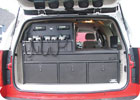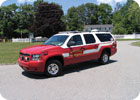Wireless and Contactless, Government Leads the Way

Wireless communications supports the security and life safety needs of government vehicles at two Northern California cities.
Who would have guessed it? In the face of tight budgets, slow tech starts, standards fights and Orwellian fears, government – from local cities to Washington, D.C. – lead their corporate brothers and sisters when it comes to wireless access and video, smart cards and mobile command and control centers.
It’s been a stop and start affair, as Bill Stover knows.
Stover, Mid-Atlantic and government sales manager for Continental Access, follows the alphabet soup of the U.S. Government’s efforts to create better individual credentials. “It’s a matter of the security of the card and integrity, data transmission and encryption. Government has gone to a new format – three handshakes. The more complex PIV II format demands faster, less than a second, processing.”

A PERFECT MARRIAGE
Software is at the heart of accompanying such demands.While FIPS 201 signals the marriage between the card and reader, “you got to take it to the controller so that software allows entry into a building,” pointed out Stover. A next step is a single sign-on for physical and logical access.
What corporate security is learning from government’s card experience is the need for software versatility – readers need to read different existing formats – in a quick way as well as the advantage of open architecture in wireless and wired environments, said Stover.
Despite being lower on the government totem pole, some American cities are pioneers when it comes to wireless integrated into security systems.
Just this fall, for example, Chicago’s Office of Emergency Management and Communications (OEMC) kicked off one of the most advanced city-wide intelligent security system ever conceived.
In collaboration with Firetide and Genetec, IBM deployed infrastructure build-out with plans to expand the network throughout the city. In the first phase, the surveillance strategy aims to capture, monitor and fully index video for real-time and forensic-related safety applications. This entailed building a unified fiber network throughout the downtown Chicago area, deploying a critical wireless infrastructure to offer flexibility as required, installing hundreds of new surveillance cameras, linking thousands of preexisting cameras to the network and creating a fully redundant backend system to monitor the video, store the images and allow for business continuity and disaster recovery applications.
LICENSE PLATE RECOGNITION
There’s also talk of adding security cameras with license plate recognition and wireless communications to the city’s street sweepers. That design is as much revenue generation as it is security.While Chicago is following the theme of “make no small plans,” other innovative government wireless security solutions are tucked into a vehicle.
A case in point: Chevy Suburbans delivered to the Rosevillle and Rocklin fire departments of Northern California. Built ons by Odyssey, the command and response units are painted red and white with reflective and gold leaf lettering and have very intricate cabinet systems consisting of seven separate cabinets assembled together to offer command and equipment storage. From the rear, you can easily access radios, command board, files and tools from different size drawers and compartments. From the ceiling drops down a 15 inch flat screen to view TV broadcasts, especially from news helicopters, but also to view signals from department thermal imaging cameras. With all of the communications equipment there are 11 antennas carefully positioned on the roof.
Wireless is ideal for harsh government site environments.
For example, VideoComm Technologies, with a diverse range of UHF, 900MHz, 1.2GHz, 2.4GHz and 5.8GHz wireless transmission products, has solar power systems.
SOLAR POWER
This wireless solar power kit is designed to supply a reliable source of electricity when conventional power sources are not available. When used in tandem with a wireless video device, these solar power units create a fully autonomous surveillance system for remote video monitoring.Then there are wireless needs at government construction sites.
One solution from DeWalt, the MOBILELOCK is a stand alone, portable, wireless locating and alarm system that is easily mounted to equipment using integrated heavy-duty magnets or fastening the unit into place using screws.
Looking for a reprint of this article?
From high-res PDFs to custom plaques, order your copy today!





